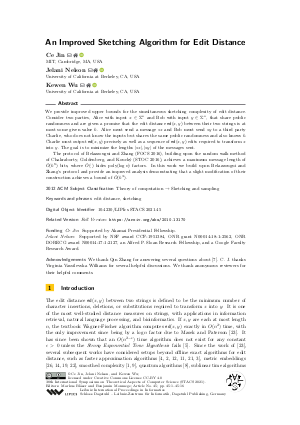@InProceedings{jin_et_al:LIPIcs.STACS.2021.45,
author = {Jin, Ce and Nelson, Jelani and Wu, Kewen},
title = {{An Improved Sketching Algorithm for Edit Distance}},
booktitle = {38th International Symposium on Theoretical Aspects of Computer Science (STACS 2021)},
pages = {45:1--45:16},
series = {Leibniz International Proceedings in Informatics (LIPIcs)},
ISBN = {978-3-95977-180-1},
ISSN = {1868-8969},
year = {2021},
volume = {187},
editor = {Bl\"{a}ser, Markus and Monmege, Benjamin},
publisher = {Schloss Dagstuhl -- Leibniz-Zentrum f{\"u}r Informatik},
address = {Dagstuhl, Germany},
URL = {https://drops.dagstuhl.de/entities/document/10.4230/LIPIcs.STACS.2021.45},
URN = {urn:nbn:de:0030-drops-136905},
doi = {10.4230/LIPIcs.STACS.2021.45},
annote = {Keywords: edit distance, sketching}
}

 Creative Commons Attribution 4.0 International license
Creative Commons Attribution 4.0 International license


